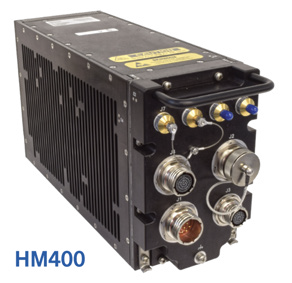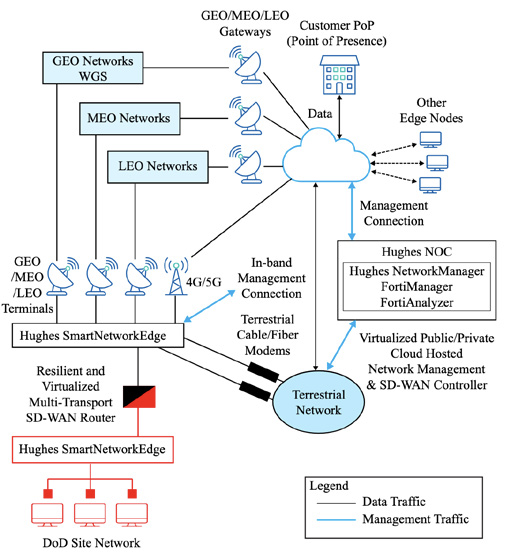Raghunandan Janardhan, Vice President, Hughes Defense and Government Systems
Hybrid communications including software-defined intelligent networking will ensure
no single point of failure
Over the last few years, U.S. military decision makers have recognized that their unique, siloed communications networks will not provide the resilience needed across today’s contested battlespace.

Each system uses a different technology that does not provide users with an easily accessible backup capability if a system or network is disrupted. Department of Defense (DoD) leaders are transforming their strategies based on this circumstance since military teams cannot fulfill their missions if they are disconnected.

The DoD is starting to implement a hybrid mix of communications technologies, including both commercial and military solutions, that can talk to each other to ensure no single point of failure in their communications architecture. This redundancy is very valuable, but many of today’s military networks cannot ensure access to these transports in real time, when the user needs it most.
Commercial satellite communications providers have created intelligent, software-defined networks with autonomous network orchestration that leverages the redundant transport paths, so all users have resilient services and stay connected.
The Hughes Defense team has worked with the DoD to develop and demonstrate this flexible network orchestration that can keep information moving at mission speed to help connect people, weapons, sensors and other critical resources.
DoD is transforming
satcom for greater
resiliency
The DoD uses many different satellite communications networks to support global operations, including the Defense Satellite Communications System, the Wideband Global SATCOM, the Advanced Extremely High Frequency System, the Mobile User Objective System, as well as other networks and commercial SATCOM networks.
These disparate, unique systems have helped to keep the DoD’s communications secure and resilient. In the last few years, decision makers have realized that operating these separate systems is a disadvantage because adversaries can disrupt one or more systems and disable military operations.
GovCIO reported comments from Colonel Nathan Vosters, director of requirements, resources, and programs (S8) for Space Forces – Indo-Pacific during October’s TechNet IndoPacific. He believes that bespoke and insular systems will no longer be part of the military’s cybersecurity posture.

Artistic rendition of the Hughes JUPITER 3
The DoD has learned that commercial industry can enhance its national security architecture very quickly by supplying more satellites with many innovative and secure capabilities.
DoD has been working with commercial providers to create a resilient, flexible SATCOM architecture for all these capabilities. This started in 2017 when the U.S. Air Force Space and Missile Systems Center (SMC) launched the COMSATCOM Pilot Program, where several commercial providers helped assess the ideal hybrid SATCOM architecture and how diverse systems could work together to enable more flexible and resilient military satellite communications.
In second phase activities, Hughes built on recommendations from the first study to explore how an interoperable system solution can be implemented effectively. Hughes produced a new Terminal Management Agent (TMA) software implementing Flexible Modem Interface (FMI) standard for demonstration and evaluation.
Hughes demonstrated the TMA/FMI technology to the DoD using a ground terminal with an auto-tracking antenna, spanning three satellites, three modems and two service providers. Hughes then demonstrated the TMA/FMI and Enterprise Management and Control (EMC) technologies with full Primary, Alternate, Contingency, Emergency (PACE) planning and Situational Awareness using a Hughes software-defined HM400 modem and a GetSat Ku-band aero antenna with a video sensor and a Comtech DMD-2050E.
In 2022, the DoD CIO Office issued the Enterprise SATCOM Management and Control Implementation Plan as guidelines for EMC that will support resiliency and interoperability objectives across commercial and DoD satellite communication systems.
This plan also helped establish foundational capabilities necessary for the ongoing future SATCOM Force Design, including increased reliance on commercial SATCOM. While this collaboration was taking place, General John W. Raymond issued the “Fighting SATCOM” strategy, stating that this architecture needs to deliver enterprise SATCOM capabilities to the Commander of the United States Space Command, to support joint warfighters across the full spectrum of conflict, at the speed of relevance, and in contested, degraded, and operationally limited environments.
Hybrid satcom and
wireless architecture
with automation
ensure flexible,
real-time
communication
o support these goals of interoperability and resilience, the redesigned, hybrid communications architecture will need to provide user access to a mix of communications technologies, including both commercial and military solutions from SATCOM as well as advanced terrestrial 5G wireless technology.
These capabilities will expand the amount of capacity available globally and in specific, ‘hot’ regions, using the global reach of Low Earth Orbit (LEO) satellites and the extremely high capacity available from state-of-the-art Geostationary Equatorial Orbit (GEO) satellites, including the JUPITER 3 (Hughes/EchoStar) satellite.
This increased capacity will deliver much-needed redundancy, but the DoD architecture will deliver more benefits by adopting the seamless connectivity model used in today’s terrestrial wireless communications architecture. Current wireless services are not delivered by separate, siloed systems; wireless networks are interoperable so users can access many open-standards technologies and providers, giving users more levels of service and quality of service.

Users expect that they will be able to use their devices even if a network has an outage. Wireless providers quickly access another tower or another system to ensure seamless, real-time communications. For enhanced military readiness and mission success, the DoD needs to provide military SATCOM and wireless users with real-time access.
Military users are seeing how flexible network orchestration works to support PACE planning for real-time communications
Beyond having communications redundancy, military teams worldwide know they need to maintain operability, interoperability, and continuous communications regardless of the operating conditions and the redundant communications paths on their network.
Developing PACE communications plans help organizations prepare to deploy various backup communications capabilities in out-of-the-ordinary situations, giving options for redundant, reliable communications capabilities if primary capabilities are disrupted or degraded. PACE plans can become a game changer if the plan’s stages can be automated. In today’s fast-paced, electronic battlespace, PACE plans need to provide more resilience and speed of deployment beyond just giving multiple paths.
As mentioned by the U.S. Army during a recent event, the network provides the underlying structure to ensure that all users, weapons, sensors and other nodes worldwide stay connected. The network must work without users having technical expertise in repairs, upgrades and scaling up and down.
Agile, software-defined networking (SDN) will integrate, synchronize, and orchestrate all these communications networks so they can anticipate and realign assets in near real time.
For the DoD, an SDN would enable a network administrator to shape traffic from a centralized control console without having to touch individual switches and deliver services to wherever they are needed in the network, without regard to what specific devices a server or other hardware components are connected. The key technologies for SDN implementation are functional separation, network virtualization, and automation through programmability.
Hughes is working with various military users to demonstrate how software-defined network management and orchestration can become the game changing capabilities they need. The technologies ensure resiliency and uninterrupted communications using hybrid networks, even if there is interference or an outage on their network.
Defense Experimentation Using Commercial Space Internet (DEUCSI), managed by the U.S. Air Force Research Lab (AFRL), is exploring how to augment military communications by leveraging the growing commercial satellite internet industry. Hughes is supporting AFRL in developing a flexible SATCOM network which can integrate government, military and commercial satellite constellations and bandwidth for encrypted and non-encrypted communications and data sharing.

Hughes is supporting AFRL in developing a flexible SATCOM network which can integrate government, military and commercial satellite constellations and bandwidth for encrypted and non-encrypted communications and data sharing. Using many bands and technologies, users will gain access to critical data in real time, even in disrupted, disconnected, intermittent and low-bandwidth circumstances. This AFRL project will take primary, alternate, contingency, emergency (PACE) communications planning to another level supporting ground- and air-based missions.
The EchoStar team, led by Hughes, demonstrated, software-defined network capabilities at the U.S. Navy’s Whidbey Island Air Station (NASWI) and in Hawaii. This demonstration showed the U.S. Navy our highly flexible and resilient mission planning capabilities automatically switching communications paths to ensure uninterrupted access to situational awareness information.
The powerful Network Management System (NMS) and Smart Network Edge (SNE) technologies dynamically planned and provided common operating pictures for situational awareness that supported Automated Primary Alternate Contingency Emergency (APACE) planning. This software-defined capability changed the communications path, Quality of Service (QoS), and various time/space-based resource commitments to speed up changes and access to the network’s SATCOM resources. Essentially offering a communications path that is always “on the net.”

Agile, software-defined networking and orchestration for SATCOM and other wireless technologies like 5G will simplify the integration and synchronization of these hybrid communications networks. DoD will have more flexible, scalable networks to ensure more resilient, real-time communications. This capability will also help the DoD adopt other commercial innovations, like the modular Open RAN 5G networking project at Fort Bliss.
Integrating these commercial technologies can provide benefits that siloed systems cannot--optimized flexibility and control that warfighters and commanders require. Automation will offer dynamic PACE planning by leveraging an AI-based rules-based engine, delivering real-time monitoring of transport links, and enabling one or more active transports based on the platform and its deployment of the radios and terminal. In the U.S. and globally, national security requires near-real-time situational awareness and communications for mission success in contested environments.
www.hughes.com



